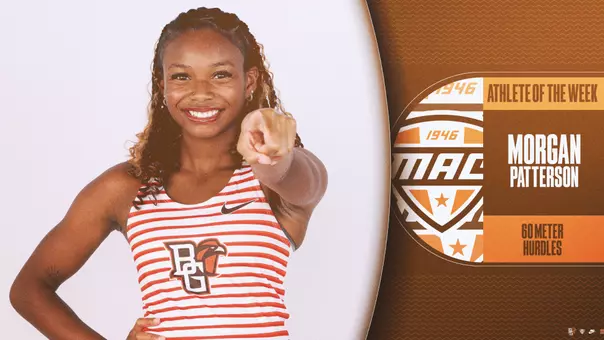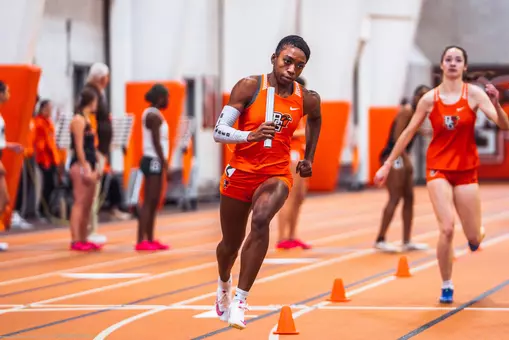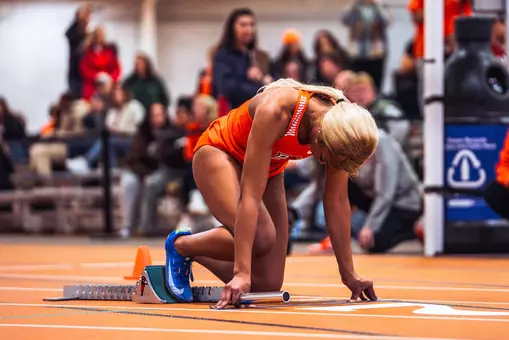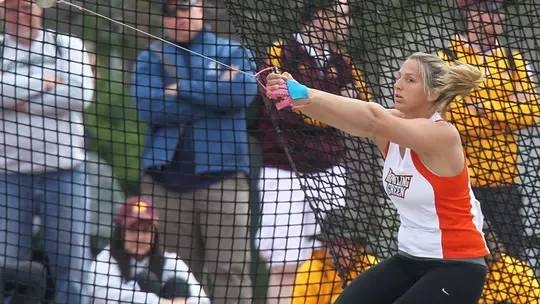
BGSU Decades Celebration – 2015: How Gymnastics, an Eager Coach and Professional Approach Helped Hammer Thrower Brooke Pleger Set a Standard for Future Falcons
Noah Tylutki, Strategic Communications Coordinator
6/16/2025
In 2015, Brooke Pleger cemented herself as one of the greatest female athletes in BGSU history. During what was her senior year, her dedication to the sport paid off as she earned her third consecutive All-America honor in the hammer throw with a third-place performance at the NCAA Championships. It was the first time a female had ever become a three-time All-American in BGSU athletics history, and she helped set the foundation and standard of excellence for the current trajectory of the track & field program. To kick off the BGSU Decades Celebration series, this is her story of how a complete commitment to her craft led to great success at Bowling Green and beyond.
BROOKE PLEGER THOUGHT her whole world was ending.
The freshman felt so upset – like she had no chance to be set up for success.
It was the spring of 2011 during her promising campaign as a first-year collegiate thrower at Bowling Green when it was announced that the track & field program’s entire coaching staff would not be returning at the conclusion of the season.
The list included Justin Carvalho, who was Pleger’s throws coach and the person who most influenced her decision to come to Bowling Green.
He even gave her the suggestion and confidence to try the hammer throw when he was her track club coach in high school, which eventually became her signature event.
“I was like, ‘I chose this school for this coach, and now you're telling me that you're getting rid of the coaching staff?’” Pleger remembered thinking. “I thought, ‘Well, that defeats the whole reason why I chose to come to Bowling Green.’
“’We'll just see what happens and hope for the best.’”
Pleger could not fathom the successes that would come in the next four years. It would lead to the best possible scenario she could have asked for as an athlete and to a coach who pulled out her greatest potential.
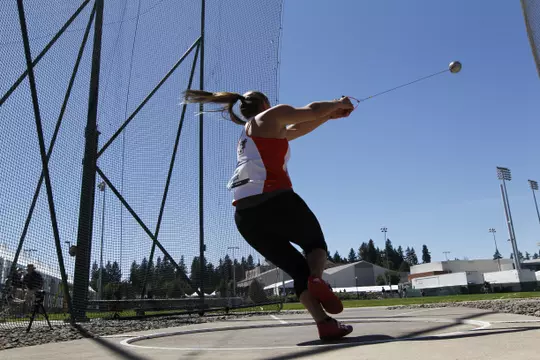
MATT CONLY SMELLED an opportunity.
New BGSU head coach Lou Snelling was putting together his coaching staff and needed a throws coach.
Conly grew up in Ohio and competed as a thrower at Ball State in the Mid-American Conference. Having spent the previous three years paying his dues as a volunteer throws coach at West Virginia University, the time to finally earn a paycheck to live out his passion at a familiar place seemed inevitable.
During his in-person interview at BGSU with a handful of athletes, a particular thrower made a keen impression on the coaching candidate.
“Brooke pulled out a sheet of paper that I could see across the table,” Conly remembered. “It had about 20 questions written on it. She put me through the ringer a little bit, but it was a good initial glimpse of the kind of person that she was – very Type-A [personality] and very organized. I think she wanted to make sure the next person that was going to take over was well prepared.”
Conly got the job and quickly realized he would be working with a special talent in Pleger.
“I’ll admit that I may not have been totally prepared,” Conly said. “I think she made me a much better coach because she was more talented than maybe I was prepared for, so I had that feeling to get better really quickly to match what her ability level was. There was some urgency on my part to start figuring things out, because once I figured out what kind of talent she possessed, I had to get better as a coach if I was going to help her be successful.”
Under Carvalho as a freshman, Pleger competed primarily in the shot put and discus as well as the hammer throw. Conly sensed her natural ability in the hammer throw, so they both agreed it was in her best interest to solely focus on that event moving forward.
After the new coaching staff had time to evaluate their athletes, they decided to redshirt Pleger and other talented individuals on the team to save a year of their eligibility as the program continued to build and develop.
Conly’s plan for Pleger during that redshirt year was to hone in on training for the hammer throw and get her more used to the event, something she had only been competing in since the summer before her senior year of high school.
Growing up, Pleger spent 13 years competing in gymnastics. As she entered Saline High School outside Ann Arbor, Mich. as a freshman, Pleger’s gymnastics coach suggested that she try track & field. Despite some resistance, Pleger listened and found her niche in the throwing events.
Carvalho, who was married to Pleger’s gymnastics coach, ran a track club based in northwest Ohio. While joining to improve her shot put and discus marks, Pleger was convinced by Carvalho to try the hammer throw during her junior year – an event that the Michigan High School Athletic Association did not sponsor in track & field.
Her natural sense of balance, proper technique and presence of performing in a moment learned from gymnastics helped Pleger realize the hammer throw was her main event as she prepared for the collegiate level.
“I think there’s just some comfort in having to rotate the body at a high rate of speed while being able to feel and tell where you’re at in space with body awareness,” Conly said. “As a gymnast, you also have to be able to perform when they call your name like a thrower.
“The moments weren’t too big for her, and I think she gained experience with having to perform through gymnastics.”
“I think [Brooke] made me a much better coach because she was more talented than maybe I was prepared for, so I had that feeling to get better really quickly to match what her ability level was. There was some urgency on my part to start figuring things out, because once I figured out what kind of talent she possessed, I had to get better as a coach if I was going to help her be successful.”Matt Conly
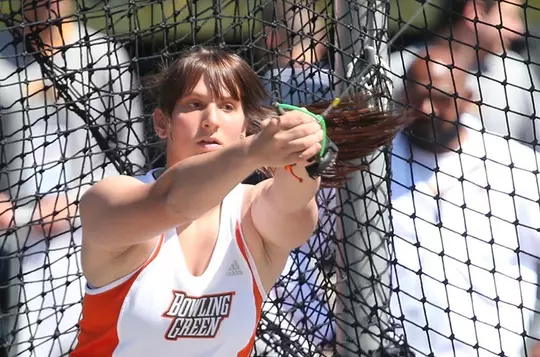
To help prepare Pleger for these moments that were to come, Conly sought out advice from coaches who specifically trained hammer throwers. He started to develop a system of training and technique that would become a great fit for her that he followed throughout her entire collegiate career.
While some of the training methods Conly used took some getting used to and were at times “frustrating” for Pleger – such as running the Doyt Perry Stadium steps for cardio – the first-year BGSU throws coach could start to see her buying in as the outdoor season started.
Competing at Michigan State’s Spartan Invitational as an unattached athlete (not competing with a school) because she was redshirted, Pleger threw the hammer 61.22 meters, which was almost eight meters further than her best throw as a freshman.
“That was the moment where I realized, ‘OK, this kid’s actually got something and she's special and that there was a lot of potential for her to become one of the best hammer throwers in the country,’” Conly remembered thinking. “I think the distance was definitely a big surprise for both of us at the time.”
Later that year, Pleger competed in a meet primarily for professional throwers at the University of Arizona. She “felt like she belonged,” as it gave her another idea of what her long-term potential was.
That potential took off in 2013.
Back to competing as a Falcon, Pleger won her first of three consecutive MAC hammer throw titles and also broke the program record in the event. She also became the first BGSU athlete to win an event at the NCAA East Regional, which qualified her for the NCAA Championships.
There at historic Hayward Field at the University of Oregon, Pleger placed seventh to take home her first All-America honor and only fifth in program history.
Pleger continued to shine in 2014.
Along with another MAC title, she was named the United States Track & Field/Cross Country Coaches Association (USTFCCCA) Great Lakes Region Field Athlete of the Year. Earning another spot at the NCAA Championships, she took third at the meet again held at Hayward Field for her second All-American achievement, becoming the first back-to-back All-American since Beth Manson in 1988-89.
It was also the highest placement at any national championships for any BGSU sport since Marny Oestreng won a gymnastics national title in 1999.
After winning a gold medal for Team USA at the North America, Central America and Caribbean (NACAC) U23 International Athletic Championships in Canada that summer, Pleger knew what the goal would be for her collegiate finale that upcoming season.
“I definitely had the mindset of wanting to win a national championship,” Pleger said. “I think it was something that over the previous years seemed like the goal became more achievable. It was my last year, so I just really wanted to go out with a bang.”
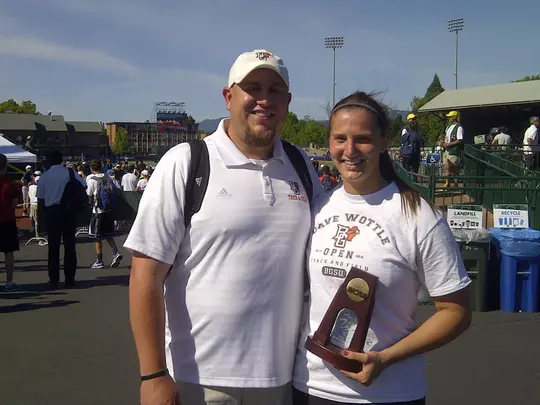
One of the keys to Conly’s training over the years for Pleger was the ability to handle a higher volume of throwing. Each year, the number of throws increased during practice sessions – eventually even training with a men’s hammer (16 pounds vs. the 8.8-pound women’s implement).
“By the time we got to 2015, I would say we were throwing quite a bit more,” Conly said. “The number of reps during a week of training was significantly higher than when I first started training Brooke. We just slowly over time were able to expand what she was capable of. We just kept putting new things on her plate, and she handled them really well. Each time we did that, it was like getting a little bit more out of what we were doing.”
With another MAC championship – where she set the school record for good with a winning toss of 69.72 meters and led the NCAA – and Great Lakes Region Field Athlete of the Year award under her belt, Pleger won the NCAA East Regional title again.
It qualified her for a chance at history – her third consecutive trip to the NCAA Championships.
After the first four throws in the infield turf at Hayward Field, the top three of Southern Illinois’ DeAnna Price, Princeton’s Julia Ratcliffe and Pleger were all within 0.3 meters of each other. However, Price, who has competed in each of the last three Olympics, threw a personal best mark of over four meters on her final attempt to take the title while Pleger settled for third.
“Brooke was right in the mix, and we missed it just a little bit,” Conly said. “She had the furthest throw of anyone in the nation coming in, but I don’t think either of us had any regret on the approach we took which was that she felt like she could win.
“The whole year, every decision we made was geared around trying to win a national title in the hammer.”
One branch of Pleger’s greatness was the professional approach she took to throwing throughout her entire career.
The more comfortable she got with Conly’s training, the more dedicated she became to her craft through sacrifice. She controlled key variables outside of practice such as her sleep, diet and hydration that kept her adept and what consistently set her apart.
“Every decision Brooke made in her life at the time revolved around trying to throw far,” Conly said. “I think she put thought into, ‘OK, if I'm going to do this, how's it going to affect my throwing?’ She controlled a lot of those little pieces that could keep getting better to make her a better thrower.
“I think that’s a really uncommon characteristic of a 19 to 23-year-old kid. She was special in that regard.”
The standard of excellence Pleger possessed helped her reach her dream of hitting the qualifying standard for the 2016 U.S. Olympic trials. After graduating from BGSU in 2015, she stayed on the BGSU staff as an assistant coach while continuing to train with Conly as a professional.
That summer, she finished in eighth place at the Trials – five spots off from qualifying for the Summer Olympics in Rio and ending her throwing career.
“When you spend that much time with an athlete, it's hard to have that time come to an end,” Conly said. “I was a young coach at the time, so that was the first person I had that had some really tremendous success. I think it was a life changing experience for her, and the four-year pursuit of getting to where we got was just really fulfilling and meaningful to both of us.”
“Every decision Brooke made in her life at the time revolved around trying to throw far. I think she put thought into, ‘OK, if I'm going to do this, how's it going to affect my throwing?’ She controlled a lot of those little pieces that could keep getting better to make her a better thrower. I think that’s a really uncommon characteristic of a 19 to 23-year-old kid. She was special in that regard.”Matt Conly
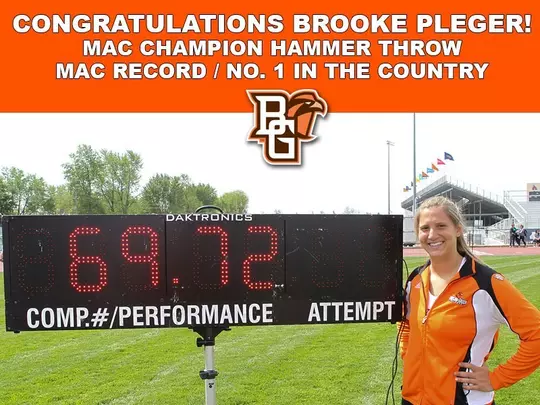
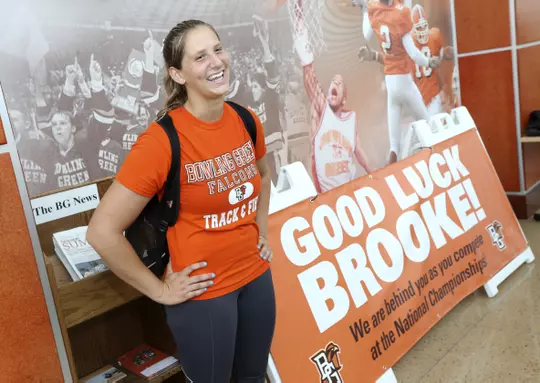
He also realizes the standard that she helped set among future Falcon throwers as well as the entire program.
Since Pleger’s graduation a decade ago, five throwers have earned a combined 19 individual MAC titles. Eight have competed at the NCAA East Regional meet, with three qualifying for the NCAA Championships.
Fourteen years after Snelling took over as head coach, his programs won both the indoor and outdoor MAC titles for the first time since 1999 and 1981, respectively.
“Lou was walking into a team that had a lot of work that needed to be done, but he always put this vision in our heads that we were the starting point and what we did today was going to affect how the team grows over the next 5-10 years,” Pleger remembered when Snelling took over as head coach. “He would say, ‘You guys are the ones that are going to be the people that launch us in that direction.’ It's been really cool to see over the years how much success the team has had, especially this year.”
Pleger (now Matuszak) married her husband, Trevor – who also threw and coached in college – in 2018 and has three children ages five and below with another due at the end of June.
They live in Pinckney, Mich. outside of Ann Arbor while Pleger works as a nurse in the University of Michigan Hospital’s pediatric cardiac intensive care unit. She mostly cares for babies through teenagers who were born with heart defects and are having open heart surgery.
“I definitely think me competing in college athletics helps with what I do now,” Pleger said. “The dedication and the focus that's required of being a college athlete has helped me in raising a family and working. The ICU is very regimented and fits my Type-A personality. There's certain things that have to be done, so I feel like all of that has come into play over the years.”
Conly, who is entering his sixth season as throws coach at Grand Valley State University, admits he still uses Pleger as an example with the athletes he coaches.
“I'm sure some of my kids get sick of hearing about her sometimes,” Conly said with a laugh. “I tell stories about her constantly.
“Sometimes, I randomly text her, ‘Thank you.’”
It is a thank you for not only creating coaching opportunities beyond BGSU for himself, but also for a program that desperately needed a spark and a standard of excellence for future Falcons to strive for so they can seek out their greatest potential.
“Lou [Snelling] was walking into a team that had a lot of work that needed to be done, but he always put this vision in our heads that we were the starting point and what we did today was going to affect how the team grows over the next 5-10 years. He would say, ‘You guys are the ones that are going to be the people that launch us in that direction.’”Brooke Pleger (Matuszak)


